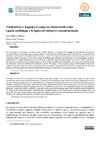Please use this identifier to cite or link to this item:
https://accedacris.ulpgc.es/jspui/handle/10553/76162
| DC Field | Value | Language |
|---|---|---|
| dc.contributor.author | Miñano Mañero, Laura | en_US |
| dc.date.accessioned | 2020-12-01T10:33:38Z | - |
| dc.date.available | 2020-12-01T10:33:38Z | - |
| dc.date.issued | 2020 | en_US |
| dc.identifier.issn | 2340-8561 | en_US |
| dc.identifier.uri | https://accedacris.ulpgc.es/handle/10553/76162 | - |
| dc.description.abstract | En este trabajo se examinan las relaciones entre el poder absoluto y el lenguaje. Los campos de concentración del régimen nacionalsocialista se entienden como el espacio donde se materializa la máxima expresión del totalitarismo. Al convertirse en sociedades forzadamente multilingües desde el inicio de la guerra, la lengua alemana puede convertirse, más que nunca, en un instrumento más de opresión al servicio del sistema: se deforma para convertirse prácticamente en un protolenguaje violento yrudimentario, y su conocimiento por parte de los reclusos se relaciona siempre con las perspectivas de supervivencia. Además, se desarrolla una lengua franca que incorpora rasgos de varios idiomas hablados por los deportados; sirve para la comunicación entre los prisioneros y pone de manifiesto las estructuras sociales del campo. En este contexto, surge inevitablemente la figura del intérprete concentracionario, el enlace comunicativo entre persecutores y perseguidos. El estudio de su comportamiento parece de especial interés para poder alcanzar conclusiones sobre la mediación interlingüística en espacios de máxima presión. | en_US |
| dc.description.abstract | This paper examines the relationships between absolute power and language. Nazi concentration camps embody the space where the maximum expression of totalitarianism was put into practice. By becoming forcedly multilingual societies from the onset of the war, the German language grew to be, more than ever, an instrument of oppression at the service of the system: deformed and distorted, it practically evolved into a violent and rudimentary protolanguage. Being able to acquire and use this new form of speech was directly related to the prisoners’ prospects of survival. In addition, a lingua franca that incorporated features of several languages spoken by the deportees naturally emerged; it was used in the communication among inmates and revealed the social structures of the camp. In this intercultural space, concentrarionary interpreters arose as the communicative link between persecutors and persecuted. The study of their behavior seems especially interesting for researchers concerned about enlightening the mechanisms through which interlinguistic mediation develops in spaces of maximum pressure. | en_US |
| dc.language | spa | en_US |
| dc.relation.ispartof | LFE. Revista de Lenguas para Fines Específicos | en_US |
| dc.source | LFE. Revista de lenguas para fines específicos [eISSN 2340-8561], v. 26 (1), p. 108-121 | en_US |
| dc.subject | 570107 Lengua y literatura | en_US |
| dc.subject | 550510 Filología | en_US |
| dc.subject.other | Comunicación | en_US |
| dc.subject.other | Interpretación | en_US |
| dc.subject.other | Totalitarismo | en_US |
| dc.subject.other | Campos de concentración | en_US |
| dc.subject.other | Communication | en_US |
| dc.subject.other | Interpretation | en_US |
| dc.subject.other | Totalitarianism | en_US |
| dc.subject.other | Concentration camps | en_US |
| dc.title | Totalitarismo y lenguaje: el campo de concentración como espacio multilingüe y la figura del intérprete concentracionario | en_US |
| dc.type | info:eu-repo/semantics/article | - |
| dc.type | Article | - |
| dc.identifier.doi | 10.20420/rlfe.2020.316 | en_US |
| dc.description.lastpage | 121 | en_US |
| dc.description.firstpage | 108 | en_US |
| dc.relation.volume | 26 | en_US |
| dc.investigacion | Artes y Humanidades | en_US |
| dc.type2 | Artículo | - |
| dc.identifier.ulpgc | Sí | en_US |
| dc.description.esci | ESCI | |
| dc.description.fecytq | Q3 | |
| dc.description.fecytpuntuacion | 27,02 | |
| dc.description.dialnetimpact | 0,0 | |
| dc.description.dialnetq | Q1 | |
| dc.description.dialnetd | D1 | |
| dc.description.erihplus | ERIH PLUS | |
| item.fulltext | Con texto completo | - |
| item.grantfulltext | open | - |
| Appears in Collections: | Artículos | |
Page view(s)
97
checked on Dec 7, 2024
Download(s)
87
checked on Dec 7, 2024
Google ScholarTM
Check
Altmetric
Share
Export metadata
Items in accedaCRIS are protected by copyright, with all rights reserved, unless otherwise indicated.
